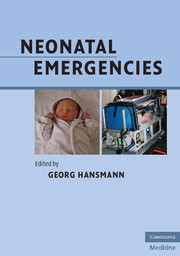Book contents
- Frontmatter
- Contents
- List of contributors
- Foreword (1)
- Foreword (2)
- Preface
- Acknowledgments
- Section 1 Organization of neonatal transport
- Section 2 Basics in cardiopulmonary resuscitation of newborn infants
- Basic equipment setup for initial neonatal care and resuscitation
- Drugs for neonatal emergencies
- Postnatal cardiopulmonary adaptation
- ABC Techniques and Procedures
- Sunctioning
- Stimulation, oxygen supplementation, bag-and-mask ventilation (M-PPV), pharyngeal/bi-nasal CPAP, and pharyngeal positive pressure ventilation
- Endotracheal intubation and gastric tube placement
- Laryngeal mask airway (LMA)
- Chest compressions
- Peripheral venous access
- Umbilical vein/artery catheterization (UVC, UAC)
- Central venous access (internal jugular vein)
- Intraosseous access
- Cord clamping
- Management of high-risk infants in the delivery room
- Monitoring in the delivery room and during neonatal transport
- Hygiene in the delivery room and during neonatal transport (infection control)
- When to call a pediatrician to the delivery room
- Checklist for the postnatal treatment of newborn infants
- Assigning individual duties in the delivery room
- Clinical assessment of the newborn infant
- Cardiopulmonary resuscitation of newborn infants at birth
- Volume therapy and sodium bicarbonate supplementation in preterm and term newborn infants
- Absolute and relative indications for neonatal transport and NICU admission
- Communication with mother and father
- Coordinating neonatal transport and patient sign-out to the NICU team
- Documentation and feedback after neonatal emergency transport
- Ethics in neonatal intensive care
- Perinatal images of preterm and term infants
- Mechanical ventilation of the neonate
- Questions for review (basics)
- References (Section 2)
- Section 3 Classic and rare scenarios in the neonatal period
- Section 4 Transport
- Section 5 Appendix
- Index
- Plate section
Central venous access (internal jugular vein)
from Section 2 - Basics in cardiopulmonary resuscitation of newborn infants
Published online by Cambridge University Press: 05 March 2012
- Frontmatter
- Contents
- List of contributors
- Foreword (1)
- Foreword (2)
- Preface
- Acknowledgments
- Section 1 Organization of neonatal transport
- Section 2 Basics in cardiopulmonary resuscitation of newborn infants
- Basic equipment setup for initial neonatal care and resuscitation
- Drugs for neonatal emergencies
- Postnatal cardiopulmonary adaptation
- ABC Techniques and Procedures
- Sunctioning
- Stimulation, oxygen supplementation, bag-and-mask ventilation (M-PPV), pharyngeal/bi-nasal CPAP, and pharyngeal positive pressure ventilation
- Endotracheal intubation and gastric tube placement
- Laryngeal mask airway (LMA)
- Chest compressions
- Peripheral venous access
- Umbilical vein/artery catheterization (UVC, UAC)
- Central venous access (internal jugular vein)
- Intraosseous access
- Cord clamping
- Management of high-risk infants in the delivery room
- Monitoring in the delivery room and during neonatal transport
- Hygiene in the delivery room and during neonatal transport (infection control)
- When to call a pediatrician to the delivery room
- Checklist for the postnatal treatment of newborn infants
- Assigning individual duties in the delivery room
- Clinical assessment of the newborn infant
- Cardiopulmonary resuscitation of newborn infants at birth
- Volume therapy and sodium bicarbonate supplementation in preterm and term newborn infants
- Absolute and relative indications for neonatal transport and NICU admission
- Communication with mother and father
- Coordinating neonatal transport and patient sign-out to the NICU team
- Documentation and feedback after neonatal emergency transport
- Ethics in neonatal intensive care
- Perinatal images of preterm and term infants
- Mechanical ventilation of the neonate
- Questions for review (basics)
- References (Section 2)
- Section 3 Classic and rare scenarios in the neonatal period
- Section 4 Transport
- Section 5 Appendix
- Index
- Plate section
Summary
Introduction
Central venous access is frequently necessary for the management of critical illness presenting in the neonatal period. Especial attention should be given to the anatomical landmarks and technique for safe and successful central venous cannulation and catheter placement. Here, basic indications and anatomy are reviewed. Then, a simple technique for internal jugular vein (IJV) cannulation and catheter placement is described that is useful in children of all ages but particularly in neonates. Sufficient experience is mandatory. Clinical judgment should be used to ensure the indication and safety of this procedure.
Indications
Lack of peripheral intravenous access (PIV)
Administration of multiple medications
Need for inotropes/vasopressors not feasible for PIV access
Tranfusions
Blood sampling
Central venous pressure (CVP) monitoring
Anatomy
The internal jugular vein (IJV; vena jugularis interna) drains blood from the brain, face, and neck. It originates from the jugular foramen at the base of the skull and travels down the side of the neck in a vertical direction towards the midline. Initially, the IJV runs lateral to the internal carotid artery, and then lateral to the common carotid, in contact with the posterior border of the sternocleidomastoid muscle (SCM), see Figures 2.30 and 2.31. At the root of the neck the IJV joins the subclavian vein to form the innominate vein (= brachiocephalic vein = vena anonyma) and enters the thoracic inlet to become the superior vena cava (SVC).
Materials
Ultrasound system, e.g., TITAN TM®
Pediatric Two-Lumen Central Venous Catheterization Kit®. Included: two-lumen indwelling polyurethane catheter (4 F × 5 cm × 22 G lumen), Tegaderm™ dressing
24 G ¾″ JELCO®
[…]
Information
- Type
- Chapter
- Information
- Neonatal Emergencies , pp. 112 - 116Publisher: Cambridge University PressPrint publication year: 2009
